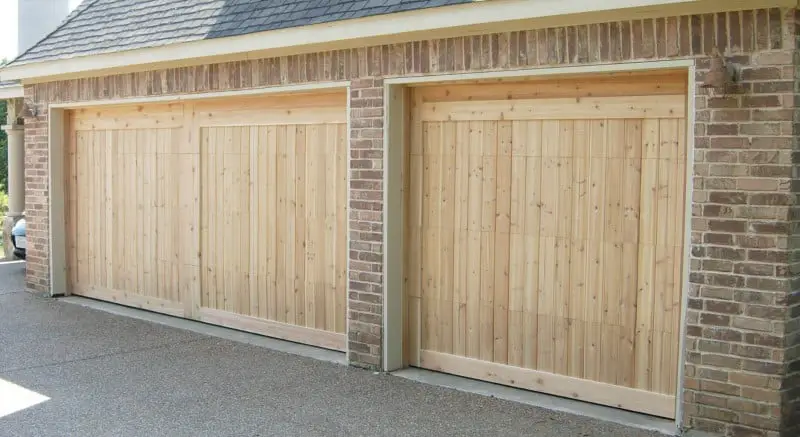Today, the garage is no longer an area you would reserve for your car or specialized projects.
More and more homeowners are realizing just how valuable this space can be when you need extra space to serve as a playground for kids or even as an extension of the living space.
In a market filled with doors made from different materials by many different brands, you need to be watchful when choosing a product for your garage.
More important of all, you need to put your needs first.
Six Manufactured Home Garage Door Shopping Factors
Here are the factors to bear in mind when buying a garage door:
- Material, Size, and Style
- Garage Door Hardware & Accessories
- Garage Function – Is it a workshop or a living area?
- Maintenance Considerations
- Value, Cost, & Material
- Door Warranties
1. Material, Size, and Style
The material used to make the door can influence its durability and the aesthetics pretty the same way as style.
So, when choosing the door based on the material of construction, you first need to figure out what type of material will best fit the environment of your home and your lifestyle.
For instance, you don’t want a wooden door if you live in a wet climate.
Three Common Garage Door Materials
Here are some of the commonly used materials for garage doors:
- Wood
- Steel
- Aluminum
Also, there are multiple ways to customize almost any kind of garage door to fit your specific design needs.
You can choose to customize it yourself or ask the supplier to customize it for you.
Five Common Garage Door Styles
The door can be:
- Carriage House
- Stained/Painted
- Contemporary
- Traditional Style
- Windows/No Windows
Customization lets you enhance the appearance of your garage.
Sizes
Size is one of the first things you should make up your mind first before looking further.
Measure the height (H), width (W), and thickness (B) of the existing door on your garage, and take those measurements to your local store or dealer.
Styles
The door’s style should appeal to the eye and complement the exterior of your home and the rest of the garage.
Window panels are some of the best ways of adding a personal feel to the garage door.
Another way of adding style is by choosing an enticing panel design.
Most of the panel designs you will find out there falls into four popular groups of main panel designs:
Carriage House Panels
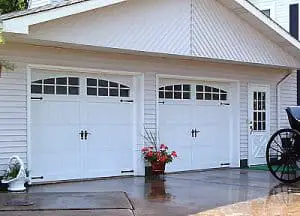
If you are looking for panels that can add character to the typical traditional raised panels, choose these panels (see image above).
Flush Panels
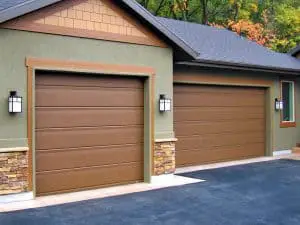
They are flat, slightly textured (mostly fine-textured) panels that you can use to complement the wall surrounding the area without drawing attention to the garage door itself.
Long Raised Panels
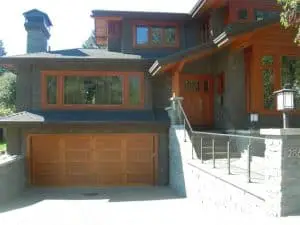
These panels give distinction and depth to the garage door while adding character to the overall appearance of your home.
Short Raised Panels
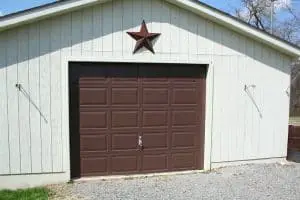
These are perfect panels for you if you want to lend depth to your garage door.
They can also be a great addition to homes with Victorian-style or those with an intricately detailed trim, symmetrical facades (like those found in colonial-style homes), or those featuring strong architectural lines found in Tudor homes).
Steel doors are probably the most common type of garage door in terms of material of construction, and also the most economical choice you could make.
Many manufacturers offer multiple colors from their factories, and most door models can be easily painted to match the color scheme of your home.
Three Common Steel Door Types
Here are the most common types of steel doors:
Single-layer Doors
They are stamped from one sheet of steel (galvanized). They are normally the most economical of all metallic garage doors.
Double-layer steel
These steel doors come with a skin of galvanized steel with a backer of a thick layer of polyurethane or polystyrene. The backer offers additional insulating value and soundproofing properties to the door.
Triple-layer doors
These doors are made from the same materials with double-layer doors except that they feature an additional galvanized skin inside to protect the polyurethane/polystyrene from damage.
The extra layer of steel means that triple-layer doors are the strongest, most durable, soundproof, and secure of all metallic garage doors.
These are also available with thicker insulation for greater R-value (a measure of thermal resistance).
2. Garage Door Hardware & Accessories
Will it be easy to find the hardware and accessories necessary to repair the garage door of your liking?
- Hardware can be an affordable and easy way to make updates on the look of your door.
- Choose a door with handle sets and hinges that can be easily sourced from your local spares shops.
- Also, consider the ease of painting the simulated windows in case you want the door to match the looks of the rest of your home.
- Furthermore, make sure the garage door opener of your choice is compatible with the door of your liking.
3. Garage Function – Is It A Parking Area, Gym, Workshop, Living Area?
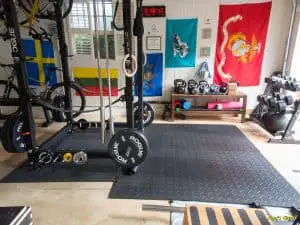
It is not uncommon for homeowners to use the garage as a living area.
You are also allowed to occasionally chill in this space as you work on your latest projects, in which case you would bring in a few chairs and a table.
Even more encouraging, some homeowners don’t shy away from using their garages as cozy extensions of their main home as:
- children’s play spaces
- garage gyms
- hobby areas
- workshops
- laundry rooms
- etc.
In these cases, remember to choose a garage door that keeps a comfortable temperature for occupants and one that upholds the energy-efficiency of the rest of the space:
Good Insulation
Again, choose a door with a higher R-value value (at least 3) if you live in moderate – temperate climates.
If your home is situated in harsher climates, air a bit higher, something in the region of R-value – 10.
Choose A Door with Weather Seals Between Its Sections
Some doors come with seals designed to lodge in the mating surface of the panels.
It may also resemble a gasket material designed to compress when the garage door is closed.
Threshold/Bottom Seal
If the door does not come with a bottom-placed seal (as it’s standard), you can be free to add one to ward off rainwater and drafts.
4. Maintenance Considerations
There will be a certain level of maintenance work to consider regardless of the kind or type of door on your garage.
Generally, wooden garage doors require more upkeep and maintenance compared to those made of aluminum or steel.
That’s because wood is more vulnerable to the insults of nature than most other materials.
Aluminum and steel, however, can easily dent compared to wood but buying a metal of a thicker grade can help reduce dings and dents.
If you want the looks of a wooden garage door but you aren’t willing to meet the maintenance cost, you can go for a steel door designed to imitate the appearance of wood.
This type of steel garage door is quite common and brings the best of both sides.
Another maintenance factor worth considering is the durability of the door – you want a garage door that will keep delivering for long while keeping its appearance.
General, you want something of high quality built that was built to last.
An average garage door (already installed) can last for the utmost 20 years with great maintenance, regardless of the material of construction.
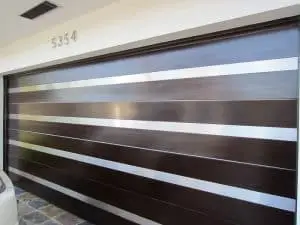
Insulated Garage Doors
Why would you choose an insulated garage door if you don’t even live in the garage?
Well, it’s for the general efficiency of your home. If your garage is located in a cold climate zone, it is important to select a garage door that’s going to boost the efficiency of the home.
More importantly, you don’t want a door that will compromise the home’s efficiency.
With extreme temperature changes, it becomes essential to know the kind of door suitable for your garage and whether or not the R-value of the material should be considered.
If your garage was designed to stand separately away from your house, and there’s nothing in it that may be sensitive to changes in temperature, then a door with insulation properties may not be so important.
For the garage that is attached to your home or another garage, insulated doors with a high R-value can be useful in reducing the amount of air that enters or leaves your garage.
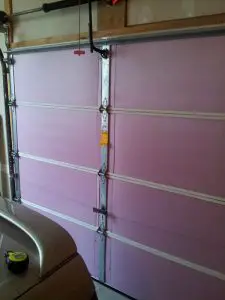
Here are a few questions worth asking yourself when figuring out whether an insulated door is necessary.
- Is there a balcony or living space over the garage? Is it detached entirely from the home?
- Will insulated doors be appropriate for your garage? Would they be stronger for the job than uninsulated doors?
- Can insulated doors be silent/quiet enough for your garage or you’d rather go for uninsulated doors?
- How thick do you want your garage door to be? Thickness is directly proportional to the insulation properties of the door
- Do you want your garage door to come with weather stripping to boost its insulation properties?
- What is the difference in pricing between uninsulated and insulated garage doors?
- What kind or type of insulation do you want on the door? Polystyrene, polyurethane, or another type of material?
5. Value, Cost, & Material
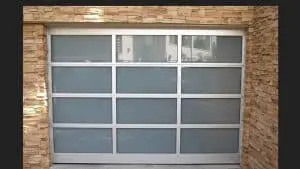
Once you have considered all the different factors for purchasing a new door for your garage, the last question should be simple and straightforward: are you getting the value of your money in the garage door of your choice?
Once again, we will bring the material into the mix because the material of construction has a remarkable influence on the cost and value of the garage door:
Aluminum And Glass
You are already used to these materials if you are into the world of cars and car washes, but this modernist construction often features tempered all-glass (sometimes acrylic) panels that have been set in anodized frames of aluminum.
Choices of glass type and frame finishes make for contemporary styling.
- Drawback: Glass is highly fragile
- Insulating value: mostly negligible
- Cost for a 16 x 7-foot double garage door: between $1,500 and $2,000.
Steel
Most of the premium-quality steel garage doors you will find feature outer layers with heavy-gauge steel that has been embossed to imitate stucco or wood grain.
Overlays, such as cross-buck designs or moldings, give the appearance of carriage doors. They often feature foam cores that add insulating values and strength.
Most steel doors out there can be purchased easily with factory-applied layers of finishes.
Though color choices can be limited, this type of door is almost maintenance-free.
Also, a buyer can order primed steel or even choose to go with painted options so as to match house colors.
- Drawback: Steel can dent quite easily
- Insulating values: R-6 to R-17
- Cost for 16 x 7-foot double garage door: between $750 and $3,500.
All wood
All wood is for architectural purists.
Garage doors with all-wood construction tend to be moisture-resistant especially those featuring cedar and redwood.
Wooden doors, especially those made from cypress, gives you all the bragging rights you want because they are some of the best-looking garage doors you could bring in the neighborhood.
Wood has two major setbacks:
- it isn’t strong like steel
- neither is it tough as fiberglass (more on fiberglass later).
Yet wood delivers just the right curb appeal you want.
Note, however, that wooden doors, just like any other material, comes at multiple prices — and different levels of quality as well. The best garage doors come with all-wood panels and frames.
Opt for a product with polystyrene backing. This is important in adding some insulating value to the door. The prefinished stain unit can also be beautiful on your garage
- Drawback: Needs periodic refinishing (do you have time for that?)
- Insulating values: between R-3 and R-6.
- Cost for 16 x 7-foot double garage door, low quality: between $400 and $700; superior quality: between $1,200 and $4,000 and up.
Fiberglass
Tell me the material that has been gaining on all other popular materials for garage doors? It certainly is fiberglass.
Right now, fiberglass garage doors are some of the most popular out there, and also some of the best if not the finest.
The best thing about Fiberglass is its resistance to moisture encroachment, insect destruction, and resistance to humidity-induced warping.
The thick outer skin that characterizes most fiberglass doors often surrounds an inner core made of foam which in turn coats the framework of steel.
As such, fiberglass doors are remarkably strong and stable.
Fiberglass excels at imitating the grain patterns and colors of real woods especially those of mahogany, cherry, and oak.
- Drawback: Single-layer versions tend to be brittle.
- Insulating values: between R-4 and R-12
- Cost for16 x 7-foot double garage door: between $1,100 and $1,800
Composite wood
The sandwich construction of composite garage doors features a strong, insulating central core of polystyrene carefully wrapped in composite wood.
The panels are often made from weatherproof resins and wood fibers.
Many manufacturers prefer recycled wood fibers on panels, adding a small green factor.
Often molded with a grain pattern, composite wood is very difficult to tell apart from the real wood.
Unlike wood, however, these garage doors never split, rot, or crack.
They are also factory finished, although some can be easily painted or custom stained.
- Drawbacks: Nearly as expensive as real wood.
- Insulating values: between R-5 and R-8.
- Cost for 16 x 7-foot double door: between $1,200 and $2,200.
6. Garage Door Warranties
Go for a garage door with a friendly warranty.
A warranty is one of the defining factors of the durability of the door – a longer warranty is an indicator of longer durability.
If the brand you are interested in does not provide any sort of warranty for their doors, that’s a red flag.
Reputable companies in the market offer some sort of warranty on their items as a way of backing the quality of their products.
In a nutshell
So, what should you look for in a garage door? Of course, you need to consider your specific needs first. But other things as the material of construction comes into the mix.
The material used to make the door can influence its durability and the aesthetics pretty the same way as style.
Therefore, when choosing the door based on the material of construction, you first need to figure out what type of material will best fit the environment of your home and your lifestyle.
Will it be easy to find the hardware and accessories necessary to repair the garage door of your liking?
Choose a door with handle sets and hinges that can be easily sourced from your local spares shops.
Also, consider the ease of painting the simulated windows in case you want the door to match the looks of the rest of your home.
There will be a certain level of maintenance work to consider regardless of the kind or type of door on your garage.
Generally, wooden garage doors require more upkeep and maintenance compared to those made of aluminum or steel.
Also, go for a garage door with a friendly warranty.
A warranty is one of the defining factors of the durability of the door – a longer warranty is an indicator of longer durability.

